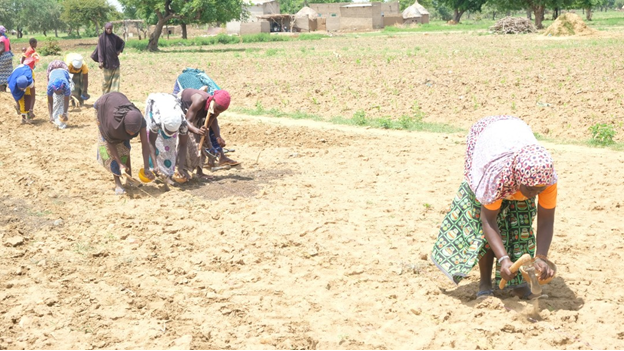Burkina Faso has a long history of land interventions aiming to achieve tenure security at the local level. The “Observatoire National du Foncier au Burkina-Faso” (ONF-BF) is one of the key players in the country working on mapping land rights within communities at commune-level. How does ONF-BF address the challenge of not only attaining tenure security through mapping, but ensuring these tenure rights last over time? LAND-at-scale interviewed Issifou Ganou and the technical team members of ONF-BF, to learn more about their approach in the LAND-at-scale project in Burkina Faso.
|
Mr. Issifou Ganou, Executive Secretary of ONF-BF, introduces the LAND-at-scale project in Burkina Faso while at the LANDac conference in Utrecht, last June:
|
1. What are the challenges in Burkina Faso when it comes to achieving tenure security?
“After fifteen years of adopting the national policy on rural land tenure security, ten years of implementing Law #034-2009 of June 16th,2009 on rural land tenure and two evaluations in 2014 and 2020, these main challenges remain:
-
The generalization of the land tenure security process in all communes of Burkina Faso. Only around sixty (60) communes that benefited from the technical and financial support of externally funded projects have the ability to secure their land out of a total of 351 communes.
-
The equitable access to rural land for all rural stakeholders, individuals and legal entities under public and private law (women, youth and internally displaced persons).
-
The promotion of investments, the increase of productivity in the agro-sylvo-pastoral sector in order to reduce poverty in rural areas, particularly for women, youth and internally displaced persons (IDPs).
-
The rational and sustainable management of natural resources.
- The contribution to the preservation and consolidation of social peace through the prevention and management of land conflicts.”
2. What will your strategy be in the LAND-at-scale project to address these challenges? How do you ensure the solutions proposed are sustainable?
“The implementation strategy of the LAS program in Burkina Faso is based on the appropriation of the process by the stakeholders at the local level along with three axes of intervention:
- The establishment of a communication, information/awareness and training system on land laws for the benefit of rural populations and particularly vulnerable people (namely women, youth and internally displaced persons) in 25 communes in two regions of Burkina Faso to strengthen their knowledge in order to improve equitable access to land.
-
The development of the technical and legal capacities of the agents of the rural land services and domanial offices, the local land management bodies such as the village land commissions (VLC) and the village land conciliation commissions (VLCC) of the 25 communes for a perfect understanding of the procedures to secure rural lands in compliance with the law.
The promotion of modern, innovative technologies adapted to Burkina Faso's land legislation, such as the Mobile Application to Secure Tenure (MAST) for a participative, low-cost and accessible land tenure security for vulnerable groups. - The assistance of vulnerable groups, particularly women, youth and internally displaced persons (IDPs) in the acquisition of secured lands for their “agro-sylvopastoral” production needs in order to contribute to the reduction of poverty.”
3. The LAS project in Burkina Faso scales up experiences from the ASTER project funded by USAID. What are lessons learned with regards to sustainability on that project that you will incorporate in your strategy for the LAS project?
“The ASTER project has a good experience in securing lands in the rural areas for women and youth using the MAST tool and the acquisition of secured land for IDPs in the form of loans.
Important lessons that LAS will consider are:
- The security context to adapt the interventions;
-
Conduct a broad campaign of communication, information, and sensitization of the population in their local languages for a better understanding of land issues, laws and regulations;
-
Involve directly the village actors in the use of simplified and low-cost technological tools;
-
Take into account in the direct support to vulnerable populations (women, youth and internally displaced persons) the acquisition of secured land or the formalization of their associations in accordance with the OHADA law.
-
Emphasize the acquisition of land tenure security documents, primarily on a collective basis, for the benefit of women, youth and internally displaced persons' groups;
-
Demarcate and formalize in a participatory way the natural resources of common use for a better protection.
LAS will effectively incorporate these experiences acquired in the Central North, in the Sahel and in the East of Burkina Faso and will adapt its intervention to the context of each of the 25 communes in the two regions located in the western part of the country (Hauts Bassins and Boucle du Mouhoun).
In addition to the experiences learned from the ASTER project, LAS plans to develop capacity building sessions in agro-sylvopastoral production for vulnerable groups, particularly women, youth and internally displaced persons, on secured sites.”
|
To learn more about the experiences and lessons learned from the ASTER project funded by USAID, have a look at this video:
Visit us :www.onf-bf.org
|
This project in Burkina Faso is part of the LAND-at-scale program. LAND-at-scale is funded by the Ministry of Foreign Affairs of the Kingdom of the Netherlands and managed by the Netherlands Enterprise and Development Agency (RVO). Read more about LAND-at-scale here or sign up for our quarterly newsletter.


